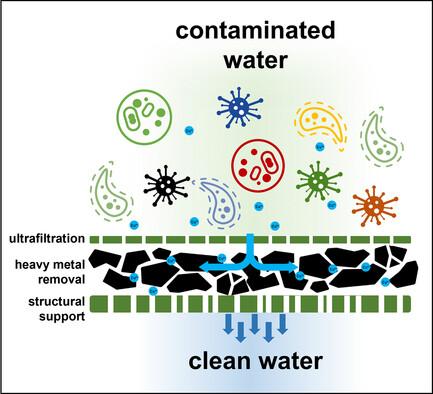两全其美:用于去除金属离子的吸附性超滤纳米纤维素-超交联聚合物混合膜
IF 11.1
Q1 MATERIALS SCIENCE, MULTIDISCIPLINARY
引用次数: 0
摘要
高效的水处理最好结合离子交换法去除硬度元素和有毒微量金属,以及超滤法去除颗粒物质。许多高比表面积聚合物材料虽然在吸附方面前景广阔,但由于溶液加工性差和背压过高,很难加工成独立膜或填料床柱。本文介绍了由夹在纳米纤维素纸中的磺化超交联聚合物组成的混合膜的制备方法。这种混合膜能有效地同时进行超滤和离子交换。增加杂交膜的聚合物负载量可提高膜的渗透率,同时增强离子吸附能力,使其数值超过大量超交联聚合物的吸附能力,从而产生协同效应。经测定,铜的最大离子吸附能力≈100 毫克/克,超过了纯聚合物(71 毫克/克)和市售离子交换树脂。在含有水硬度元素和痕量有毒金属离子的样品中进行了竞争性吸附测试,结果显示离子交换能力很强。即使满载水硬度元素,Ba2+ 和 Sr2+ 仍能从溶液中去除。本文章由计算机程序翻译,如有差异,请以英文原文为准。

Best of Both Worlds: Adsorptive Ultrafiltration Nanocellulose-Hypercrosslinked Polymer Hybrid Membranes for Metal Ion Removal
Efficient water treatment ideally combines ion exchange for the removal of hardness elements and toxic trace metals as well as ultrafiltration for the removal of particulate matter. Although promising for adsorption, many high-surface-area polymer materials cannot be easily processed into freestanding membranes or packed bed columns, due to poor solution processability and high back pressures, respectively. The preparation of hybrid membranes comprising sulfonated hypercrosslinked polymers entrapped in nanocellulose papers is described. The hybrid membranes are effective for simultaneous ultrafiltration and ion exchange. Increasing the polymer loading of the hybrid membrane produces synergy by increasing the permeance of the membranes while enhancing the ion adsorption capacity to values exceeding those of bulk hypercrosslinked polymers. The maximum ion adsorption capacity for copper is determined to be ≈100 mg g−1 outperforming that of pure polymer (71 mg g−1) and commercially available ion exchange resins. Competitive adsorption is tested in samples containing water hardness elements and trace toxic metal ions showing high ion-exchange capacities. Even when fully loaded with water hardness elements, Ba2+ and Sr2+ are still removed from solution.
求助全文
通过发布文献求助,成功后即可免费获取论文全文。
去求助
来源期刊
CiteScore
14.00
自引率
2.40%
发文量
0
期刊介绍:
Small Science is a premium multidisciplinary open access journal dedicated to publishing impactful research from all areas of nanoscience and nanotechnology. It features interdisciplinary original research and focused review articles on relevant topics. The journal covers design, characterization, mechanism, technology, and application of micro-/nanoscale structures and systems in various fields including physics, chemistry, materials science, engineering, environmental science, life science, biology, and medicine. It welcomes innovative interdisciplinary research and its readership includes professionals from academia and industry in fields such as chemistry, physics, materials science, biology, engineering, and environmental and analytical science. Small Science is indexed and abstracted in CAS, DOAJ, Clarivate Analytics, ProQuest Central, Publicly Available Content Database, Science Database, SCOPUS, and Web of Science.

 求助内容:
求助内容: 应助结果提醒方式:
应助结果提醒方式:


